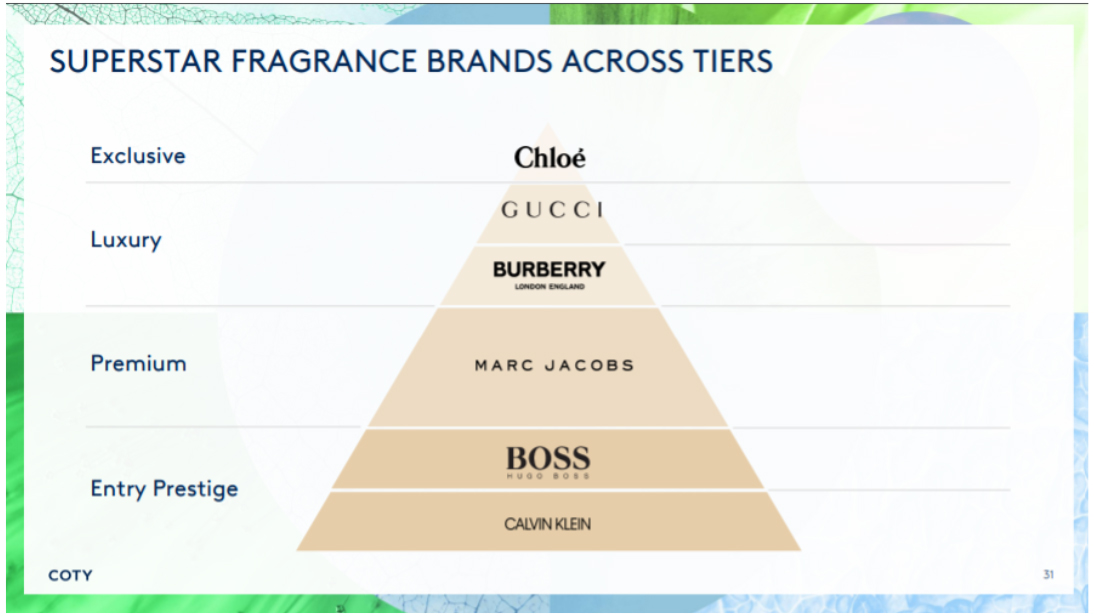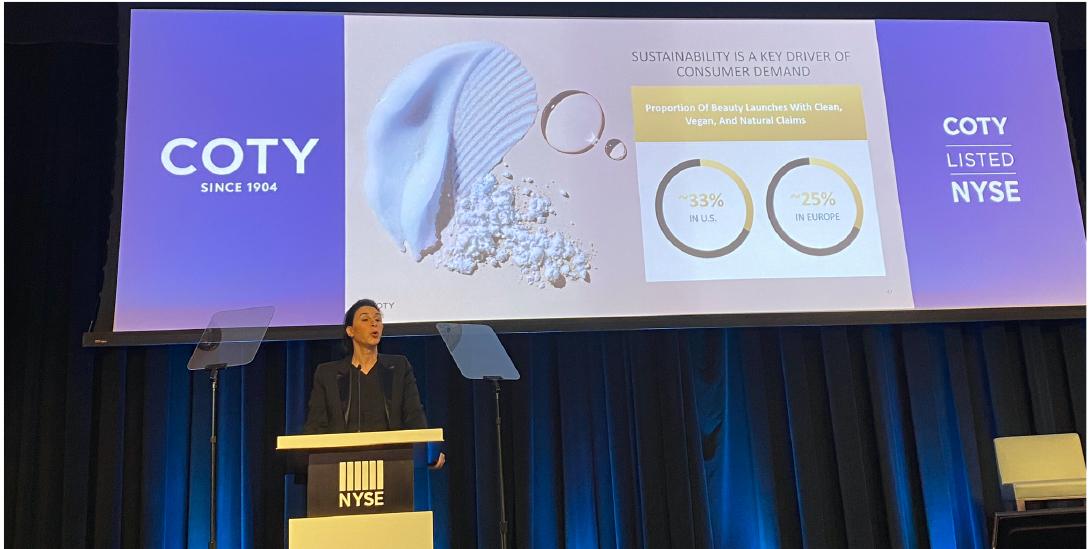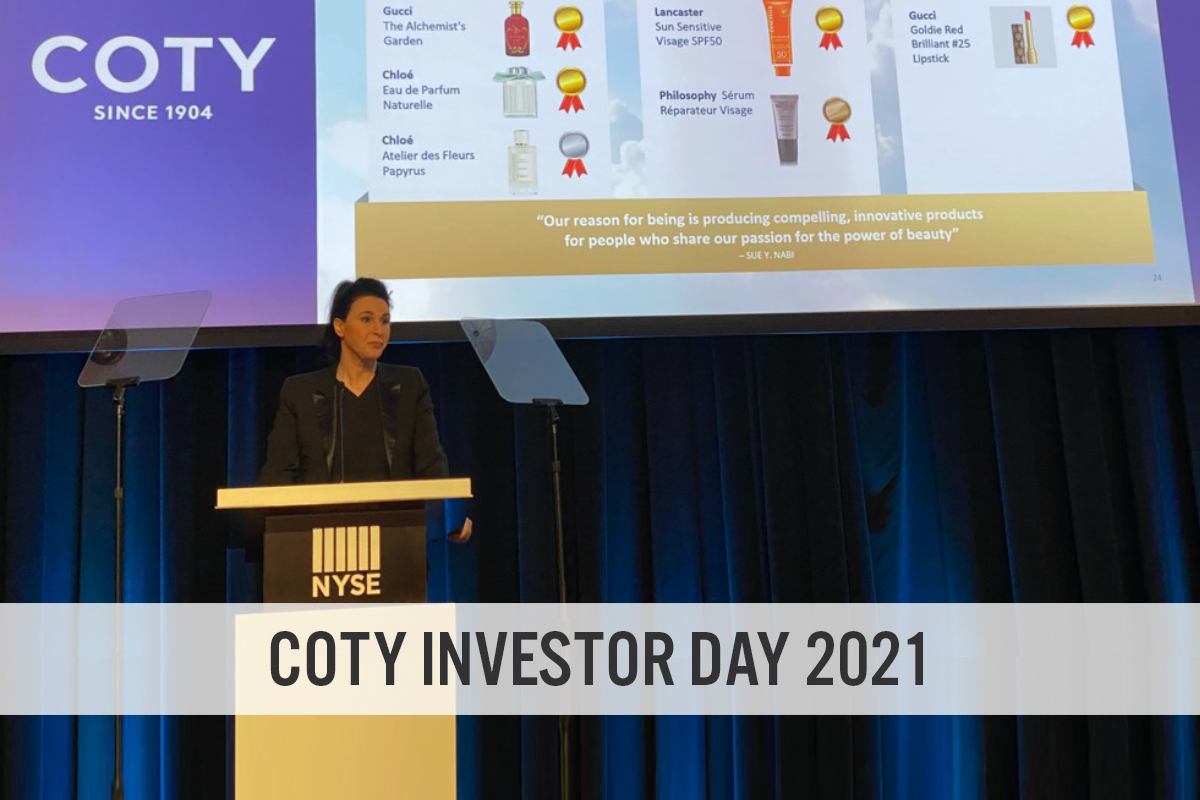What’s the Story?
Coty Inc. hosted its Investor Day at the New York Stock Exchange on November 18, 2021. The day featured management presentations by CEO Sue Nabi and her executive team.
In this report, we present insights from the event, covering the company’s growth plan through fiscal 2025 and its six strategic pillars to achieve growth.
Coty Investor Day 2021: Coresight Research Insights
Growth Plan: Three Phases
Coty reported a revenue target of $6.4–6.8 billion in fiscal 2025, up from $5.3 billion in fiscal 2022 and representing a like-for-like revenue CAGR of 6%–8%. It outlined a target for gross margin improvement of around 500 basis points and a 9%–11% EBITDA CAGR in the same time frame.
The company outlined three growth phases:
1. Stabilize and fuel
The company has largely completed this phase, having streamlined the organization in the past year by reducing overheads, headcount and salaries, as well as through its 60% sale of haircare brand Wella. Coty management also stated that it has deleveraged its balance sheet while extending debt maturities since Nabi joined the company in September 2020. As part of this phase, in April 2021, Coty set six strategic pillars for supporting its growth (which we discuss further below).
2. Build and grow
Powered by its six strategic pillars, Coty plans to move into the second phase of its growth plan in fiscal 2022, which focuses on executing on brand positioning and capitalizing on new opportunities. Operationally, this means unveiling new marketing campaigns, leading with innovations, and entering and succeeding in the key white-space opportunities. At the same time, Coty will work on SKU (stock-keeping unit) rationalization and portfolio optimization. Gordon von Bretten, Chief Transformation Officer at Coty, stated that the bottom 35% of color cosmetics SKUs have generated only 3% of sales for years; now, the company has made the decision to pull these products back from the shelves. He explained that the revenue impact of this move has been positive, as the weak SKUs have been replaced with more dynamic products that turn.
3. Growth flywheel
The company targets revenue growth that exceeds the overall beauty market from fiscal 2023 to fiscal 2025. According to management, Coty will invest in its brands and people; grow its most profitable categories, markets and channels; grow profits and margins; and generate cash and de-lever.
Growth Plan: Six Strategic Pillars
Supporting its financial goals are Coty’s six strategic pillars, which are designed to boost the growth trajectories of the company’s Consumer Beauty and Prestige divisions and utilize cost savings to fund reinvestment and drive profit and margin expansion.
1. Stablize and grow consumer beauty makeup brands and mass fragrances
This initiative spans makeup brands CoverGirl, Max Factor and Rimmel, as well as mass fragrances. CoverGirl’s heritage as the first American clean brand has been dusted off and reinvigorated for repositioning as a leader in the clean beauty segment.
2. Accelerate growth of luxury fragrances and establish the company as a key player in prestige makeup
Coty considers Prestige to be its largest opportunity, and the company is rapidly repositioning luxury fragrances while starting to build a portfolio of prestige makeup. Coty has three prestige makeup brands—Burberry, Gucci and Kylie—and six prestige fragrance brands across four tiers (as shown in the image below). The company highlighted growth in luxury consumption in China, North America and travel retail as natural tailwinds that are driving growth in Prestige.
[caption id="attachment_137974" align="aligncenter" width="700"]
 Source: Company reports
Source: Company reports[/caption]
3. Build the skincare portfolio across Mass and Prestige
The company emphasized a number of recent launches in its skincare portfolio, including CoverGirl (with five SKUs), Kylie and Kim Kardashian skincare. In addition, the Coty portfolio has seen the addition of Orveda, an ultra-premium, multi-award-winning, clean, vegan, microbiome-focused skincare brand, co-founded by Nabi and Nicolas Vu.
4. Build e-commerce and DTC expertise and capabilities
According to Coty, its digital strategy is anchored on three differentiators: leading social commerce, livestreaming and advocacy strategy; next-generation DTC (direct-to-consumer) brands; and creating innovative content and services through its partnership with beauty tech solutions provider Perfect Corp, which is working on seamlessly integrating augmented reality, virtual try-on, social selling and data-driven personalization.
5. Expand in China on luxury and select consumer beauty brands
Coty has ambitious plans for China, to grow its presence in the market from its current 3% of consolidated revenues to 10%. The company has a heightened focus on Hainan, where strong Chinese governmental support to create the world’s leading duty-free port is a significant driver of the travel retail market. In fiscal 2021, Coty’s sales in China rose by double digits, led by triple-digit growth in Hainan. At Coty, travel retail overall represents about 7% of global sales, and the company claims to hold 16% of the global travel retail fragrance market. However, the Covid-19 pandemic saw airport traffic drop by 90%, with travel retail dropping in kind, Coty stated. The company expects travel retail to return to a 20%–25% CAGR by fiscal 2025.
6. Become a beauty leader in sustainability
Nabi considers sustainability to be the ultimate driver of Coty’s innovation, and the company’s sustainability strategy, “Beauty That Lasts,” is integral to its business. The strategy was launched in 2020 and is guided by the United Nations’ (UN’s) Sustainable Development Goals. It comprises three elements:
- The beauty of people—Create a more inclusive business and society
Among its people-focused efforts, Coty reported that it is on track to reach gender pay equity by 2022, and the company has a female-majority Executive Committee and 50% female representation on its Board.
- The beauty of our product—Drive product innovation and sustainability toward the circular economy
Clean beauty is a key driver of beauty-industry growth around the world, with one-third of all US beauty launches and one-quarter of all European beauty launches in 2020 claiming clean, vegan and natural aspects, according to Coty. The company has launched a broad range of clean products, spanning fragrance, makeup and skincare—across brands such as Chloé, CK, CoverGirl, Kylie, Nautica, Rimmel and Sally Hanson.
- The beauty of our planet—Protect and conserve natural resources to achieve a healthy, clean and safe environment
Coty spent the past year completing an in-depth environmental-footprint study, and sustainability targets are in place for palm oil (the company aims to purchase 100% mass balance-certified palm oil for all production sites in coming years) and the upcycling of carbon emissions to create sustainable ethanol for Coty fragrances. In addition, by 2030, Coty plans to switch to 100% renewable electricity across all its sites (its own factories and warehouses already use 100% renewable electricity), send zero waste to landfill and recycle 80% of waste generated by factories and distribution.
[caption id="attachment_137975" align="aligncenter" width="700"]
 Source: Coresight Research
Source: Coresight Research[/caption]
Nabi’s strategy is to lead a cultural shift at Coty to a product and consumer-centric business, leveraging existing brands and relaunches with features relevant to today’s consumers (such as clean, vegan beauty) as well as focusing on social/sustainable advocacy. The company’s efforts toward premiumization in skincare and fragrance is in the early stages; we see significant opportunity in both beauty segments. Coty has a strong brand portfolio that spans mass to exclusive, heritage to celebrity labels. We expect the company to seize opportunities to beat beauty-industry growth and improve profitability.

 Source: Company reports[/caption]
3. Build the skincare portfolio across Mass and Prestige
The company emphasized a number of recent launches in its skincare portfolio, including CoverGirl (with five SKUs), Kylie and Kim Kardashian skincare. In addition, the Coty portfolio has seen the addition of Orveda, an ultra-premium, multi-award-winning, clean, vegan, microbiome-focused skincare brand, co-founded by Nabi and Nicolas Vu.
4. Build e-commerce and DTC expertise and capabilities
According to Coty, its digital strategy is anchored on three differentiators: leading social commerce, livestreaming and advocacy strategy; next-generation DTC (direct-to-consumer) brands; and creating innovative content and services through its partnership with beauty tech solutions provider Perfect Corp, which is working on seamlessly integrating augmented reality, virtual try-on, social selling and data-driven personalization.
5. Expand in China on luxury and select consumer beauty brands
Coty has ambitious plans for China, to grow its presence in the market from its current 3% of consolidated revenues to 10%. The company has a heightened focus on Hainan, where strong Chinese governmental support to create the world’s leading duty-free port is a significant driver of the travel retail market. In fiscal 2021, Coty’s sales in China rose by double digits, led by triple-digit growth in Hainan. At Coty, travel retail overall represents about 7% of global sales, and the company claims to hold 16% of the global travel retail fragrance market. However, the Covid-19 pandemic saw airport traffic drop by 90%, with travel retail dropping in kind, Coty stated. The company expects travel retail to return to a 20%–25% CAGR by fiscal 2025.
6. Become a beauty leader in sustainability
Nabi considers sustainability to be the ultimate driver of Coty’s innovation, and the company’s sustainability strategy, “Beauty That Lasts,” is integral to its business. The strategy was launched in 2020 and is guided by the United Nations’ (UN’s) Sustainable Development Goals. It comprises three elements:
Source: Company reports[/caption]
3. Build the skincare portfolio across Mass and Prestige
The company emphasized a number of recent launches in its skincare portfolio, including CoverGirl (with five SKUs), Kylie and Kim Kardashian skincare. In addition, the Coty portfolio has seen the addition of Orveda, an ultra-premium, multi-award-winning, clean, vegan, microbiome-focused skincare brand, co-founded by Nabi and Nicolas Vu.
4. Build e-commerce and DTC expertise and capabilities
According to Coty, its digital strategy is anchored on three differentiators: leading social commerce, livestreaming and advocacy strategy; next-generation DTC (direct-to-consumer) brands; and creating innovative content and services through its partnership with beauty tech solutions provider Perfect Corp, which is working on seamlessly integrating augmented reality, virtual try-on, social selling and data-driven personalization.
5. Expand in China on luxury and select consumer beauty brands
Coty has ambitious plans for China, to grow its presence in the market from its current 3% of consolidated revenues to 10%. The company has a heightened focus on Hainan, where strong Chinese governmental support to create the world’s leading duty-free port is a significant driver of the travel retail market. In fiscal 2021, Coty’s sales in China rose by double digits, led by triple-digit growth in Hainan. At Coty, travel retail overall represents about 7% of global sales, and the company claims to hold 16% of the global travel retail fragrance market. However, the Covid-19 pandemic saw airport traffic drop by 90%, with travel retail dropping in kind, Coty stated. The company expects travel retail to return to a 20%–25% CAGR by fiscal 2025.
6. Become a beauty leader in sustainability
Nabi considers sustainability to be the ultimate driver of Coty’s innovation, and the company’s sustainability strategy, “Beauty That Lasts,” is integral to its business. The strategy was launched in 2020 and is guided by the United Nations’ (UN’s) Sustainable Development Goals. It comprises three elements:
 Source: Coresight Research[/caption]
Nabi’s strategy is to lead a cultural shift at Coty to a product and consumer-centric business, leveraging existing brands and relaunches with features relevant to today’s consumers (such as clean, vegan beauty) as well as focusing on social/sustainable advocacy. The company’s efforts toward premiumization in skincare and fragrance is in the early stages; we see significant opportunity in both beauty segments. Coty has a strong brand portfolio that spans mass to exclusive, heritage to celebrity labels. We expect the company to seize opportunities to beat beauty-industry growth and improve profitability.
Source: Coresight Research[/caption]
Nabi’s strategy is to lead a cultural shift at Coty to a product and consumer-centric business, leveraging existing brands and relaunches with features relevant to today’s consumers (such as clean, vegan beauty) as well as focusing on social/sustainable advocacy. The company’s efforts toward premiumization in skincare and fragrance is in the early stages; we see significant opportunity in both beauty segments. Coty has a strong brand portfolio that spans mass to exclusive, heritage to celebrity labels. We expect the company to seize opportunities to beat beauty-industry growth and improve profitability.